Effect of Graphene Oxide on the Electrothermal and Pressure-Sensitive Properties of Carbon Fiber Cementitious Composites
Abstract
:1. Introduction
2. Materials and Methods
2.1. Raw Material
2.2. Preparation of GO Electrolyte
2.3. Preparation of GO-CF by Electrophoretic Deposition
2.4. Design of Mix Ratio and Specimen Production
2.5. Experimental Method
2.5.1. Conductivity Test
2.5.2. Electrothermal Temperature Rise Performance Tests
2.5.3. Pressure-Sensitive Performance Test
3. Results and Discussion
3.1. Characterization of CF before and after Modification
3.2. Electrical Conductivity of GO-CF Cementitious Composites
3.3. Electrothermal Warming Properties of GO-CF Cementitious Composites
3.4. Pressure-Sensitive Properties of GO-CF Cementitious Composites
3.5. Microstructure Analysis
4. Conclusions
- (1)
- The GO-modified CF not only further reduces the electrical resistivity of cementitious composites, but also reduces the required level of fiber incorporation compared to CF. Percolation thresholds are 0.7 wt% for CF and 0.5 wt% for GO-CF.
- (2)
- The GO-modified CF is more effective than CF as a conductive filler to enhance the electrothermal warming performance of the cement matrix. When the GO-CF doping is 0.5%, the temperature of the specimen increases most rapidly and the temperature rise value is the largest, and the surface temperature of the specimen can reach 30.45 °C after 900 s of energization, which is twice as much as the maximum temperature rise of CF cementitious composites.
- (3)
- Under monotonic loading, the resistivity of both CF and GO-CF cement mortar decreased gradually, and the rate of decrease was faster in the early stage, later becoming slower. Compared with the CF cement mortar specimen, the resistivity of the GO-CF cement mortar specimen decreased more. This indicates that the GO-CF cement mortar specimens have better pressure-sensitive properties. The best pressure-sensitive performance of the CF specimens was obtained when the fiber dosage was 0.7%. The best improvement in pressure-sensitive performance of mortar specimens was achieved by GO-CF when the fiber doping was 0.5%, which increased the resistivity change by 5.7% compared to CF cement mortar specimens.
Author Contributions
Funding
Data Availability Statement
Conflicts of Interest
References
- Heng, Z. Self-Monitoring of Cracking Development of Smart Concrete and Effect of Temperature and Humidity. Master’s Thesis, Dalian University of Technology, Dalian, China, 2017. [Google Scholar]
- Park, G.; Kim, S.; Park, G.K.; Lee, N. Influence of carbon fiber on the electromagnetic shielding effectiveness of high-performance fiber-reinforced cementitious composites. J. Build. Eng. 2020, 35, 101982. [Google Scholar] [CrossRef]
- Wanasinghe, D.; Aslani, F.; Ma, G. Electromagnetic shielding properties of cementitious composites containing carbon nanofibers, zinc oxide, and activated carbon powder. Constr. Build. Mater. 2021, 285, 122842. [Google Scholar] [CrossRef]
- Wang, Y.; Chung, D.D.L. Effect of the fringing electric field on the apparent electric permittivity of cementitious materials. Compos. Part B 2017, 126, 192–201. [Google Scholar] [CrossRef]
- Sun, S. Multifunctional and Intelligent Properties of Multilayer Graphene Composite Cementitious Materials. Ph.D. Thesis, Harbin Institute of Technology, Harbin, China, 2017. [Google Scholar]
- Cassese, P.; Rainieri, C.; Occhiuzzi, A. Applications of Cement-Based Smart Composites to Civil Structural Health Monitoring: A Review. Appl. Sci. 2021, 11, 8530. [Google Scholar] [CrossRef]
- Shi, L. Experimental Study on Conductive and Electrothermal Properties of Cementitious Composites. Master’s Thesis, Taiyuan University of Technology, Taiyuan, China, 2021. [Google Scholar]
- Lai, H.; Wang, Y.; Luo, H.; Prateek, G.; Lin, S.; Pan, Z.; Yang, J.; Su, Q. Influence of multi-walled carbon nanotube dispersion on the electrical conductivity and electrothermal properties of cementitious materials. Silic. Bull. 2020, 39, 3438–3443. [Google Scholar]
- Yuan, X.; Zhang, W.; Cao, P.; Yang, S.; Qin, Y. Study on the electrical and snow- and ice-melting properties of compound-doped graphene/graphene oxide-modified mortar. Funct. Mater. 2021, 52, 12100–12110. [Google Scholar]
- Huang, W.; Yang, Y.; Song, P.; Guo, J.; Zhong, X.; He, X. Study on the electrical and thermal properties of graphene-carbon fibre conductive asphalt concrete. New Chem. Mater. 2021, 49, 269–273. [Google Scholar]
- Han, B.; Wang, Y.; Dong, S.; Zhang, L.; Ding, S.; Yu, X.; Ou, J. Smart concretes and structures: A review. J. Intell. Mater. Syst. Struct. 2015, 26, 1303–1345. [Google Scholar] [CrossRef]
- Armoosh, S.R.; Oltulu, M.; Alameri, I.; Mohammed, H.M.; Karacali, T. The combined effect of carbon fiber and carbon nanotubes on the electrical and self-heating properties of cement composites. J. Intell. Mater. Syst. Struct. 2022, 142, 1–14. [Google Scholar] [CrossRef]
- Qin, Z.; Chen, X.; Zu, H.; Zhang, H.; Zhang, Y.; Yao, N.; Jiang, L. Electrothermal properties of nickel-plated carbon fibre cementitious materials. Silic. Bull. 2022, 41, 802–809. [Google Scholar] [CrossRef]
- Hambach, M.; Möller, H.; Neumann, T.; Volkmer, D. Carbon fibre reinforced cement-based composites as smart floor heating materials. Compos. Part B Eng. 2016, 90, 465–470. [Google Scholar] [CrossRef]
- Zhao, H.; Wu, Z.; Wang, S.; Zheng, J.; Che, G. Concrete pavement deicing with carbon fiber heating wires. Cold Reg. Sci. Technol. 2010, 65, 413–420. [Google Scholar] [CrossRef]
- Gao, J.; Wang, Z.; Zhang, T.; Zhou, L. Dispersion of carbon fibers in cement-based composites with different mixing methods. Constr. Build. Mater. 2017, 134, 220–227. [Google Scholar] [CrossRef]
- Tiwari, S.; Bijwe, J. Surface Treatment of Carbon Fibers-A Review. Procedia Technol. 2014, 14, 505–512. [Google Scholar] [CrossRef]
- Li, M.; Wang, H.; Zhang, C.; Deng, S.; Li, K.; Guo, X. The effect of graphene oxide grafted carbon fiber on mechanical properties of class G Portland cement. J. Adhes. Sci. Technol. 2019, 22, 2494–2516. [Google Scholar] [CrossRef]
- Lv, S.; Zhang, J.; Luo, X.; Zhu, L.; Ni, C. Microstructure and properties of graphene oxide/cementitious composites. J. Mater. Res. 2018, 32, 233–240. [Google Scholar]
- Kaur, R.; Kothiyal, N.C. Synergic influence of fly ash and graphene oxide-carbon nanotubes hybrid on mechanical, microstructural and porosity properties of cement mortars. J. Adhes. Sci. Technol. 2021, 35, 1777–1805. [Google Scholar] [CrossRef]
- Dikin, D.A.; Stankovich, S.; Zimney, E.J.; Piner, R.D.; Dommett, G.H.; Evmenenko, G.; Nguyen, S.T.; Ruoff, R.S. Preparation and characterization of graphene oxide paper. Nature 2007, 448, 457–460. [Google Scholar] [CrossRef] [PubMed]
- Kaur, R.; Kothiyal, N.C.; Singh, J. Ultrasonic and superplasticizer assisted dispersion of hybrid carbon nanomaterials (FCNT and GO): Its effect on early stage hydration and physico-mechanical strength of cement mortar. J. Adhes. Sci. Technol. 2019, 34, 192–218. [Google Scholar] [CrossRef]
- Liu, J.; Zhao, L.; Chang, F.; Chi, L. Mechanical properties and microstructure of multilayer graphene oxide cement mortar. Front. Struct. Civ. Eng. 2021, 15, 1058–1070. [Google Scholar] [CrossRef]
- Shi, X.X.; Sun, G.J. Effect of Graphene Oxide on Mechanical Properties of Cement Based Materials. Non-Met. Mines 2021, 44, 47–50. [Google Scholar]
- Babak, F.; Abolfazl, H.; Alimorad, R.; Parviz, G. Preparation and mechanical properties of graphene oxide: Cement nanocomposites. Sci. World J. 2014, 2014, 276323. [Google Scholar] [CrossRef] [PubMed]
- Lv, S.; Hu, H.; Zhang, J.; Luo, X.; Lei, Y.; Sun, L. Fabrication of GO/cement composites by incorporation of few-layered GO nanosheets and characterization of their crystal/chemical structure and properties. Nanomaterials 2017, 7, 457. [Google Scholar] [CrossRef] [PubMed]
- Wang, P.; Qiao, G.; Hou, D.; Jin, Z.; Wang, M.; Zhang, J.; Sun, G. Functionalization enhancement interfacial bonding strength between graphene sheets and calcium silicate hydrate: Insights from molecular dynamics simulation. Constr. Build. Mater. 2020, 261, 120500. [Google Scholar] [CrossRef]
- Zhao, D. Research on Surface Modification of Carbon Fibre by Graphene and Its Cementitious Composite Properties. Master’s Thesis, Jinan University, Jinan, China, 2015. [Google Scholar]
- Shang, G. Experimental Study on Fibre Dispersion and Electrical Conductivity of Carbon Fibre Cementitious Composites. Master’s Thesis, Zhengzhou University, Zhengzhou, China, 2015. [Google Scholar]
- GB/T 17671-2021; Test Method of Cement Mortar Strength (ISO Method). Standardization Administration of China: Beijing, China, 2021.
- Yang, H.; Hernandez, Y.; Schlierf, A. A simple method for graphene production based on exfoliation of graphite in water using l-pyrenesulfonic acid sodium salt. Carbon 2013, 53, 357–365. [Google Scholar] [CrossRef]
- Cui, Y.; Wei, Y. Mixed “ionic-electronic” thermoelectric effect of reduced graphene oxide reinforced cement-based composites. Cem. Concr. Compos. 2022, 128, 104442. [Google Scholar] [CrossRef]
- Sun, M.-Q. Study on the Force Electromechanical Sensitivity and Application of Carbon Fibre Concrete and Plain Concrete. Ph.D. Thesis, Wuhan University of Technology, Wuhan, China, 2002. [Google Scholar]
- Wang, H.G. Mechanism analysis of electrothermal effect. J. Xinxiang Coll. (Nat. Sci. Ed.) 2012, 29, 211–213. [Google Scholar]
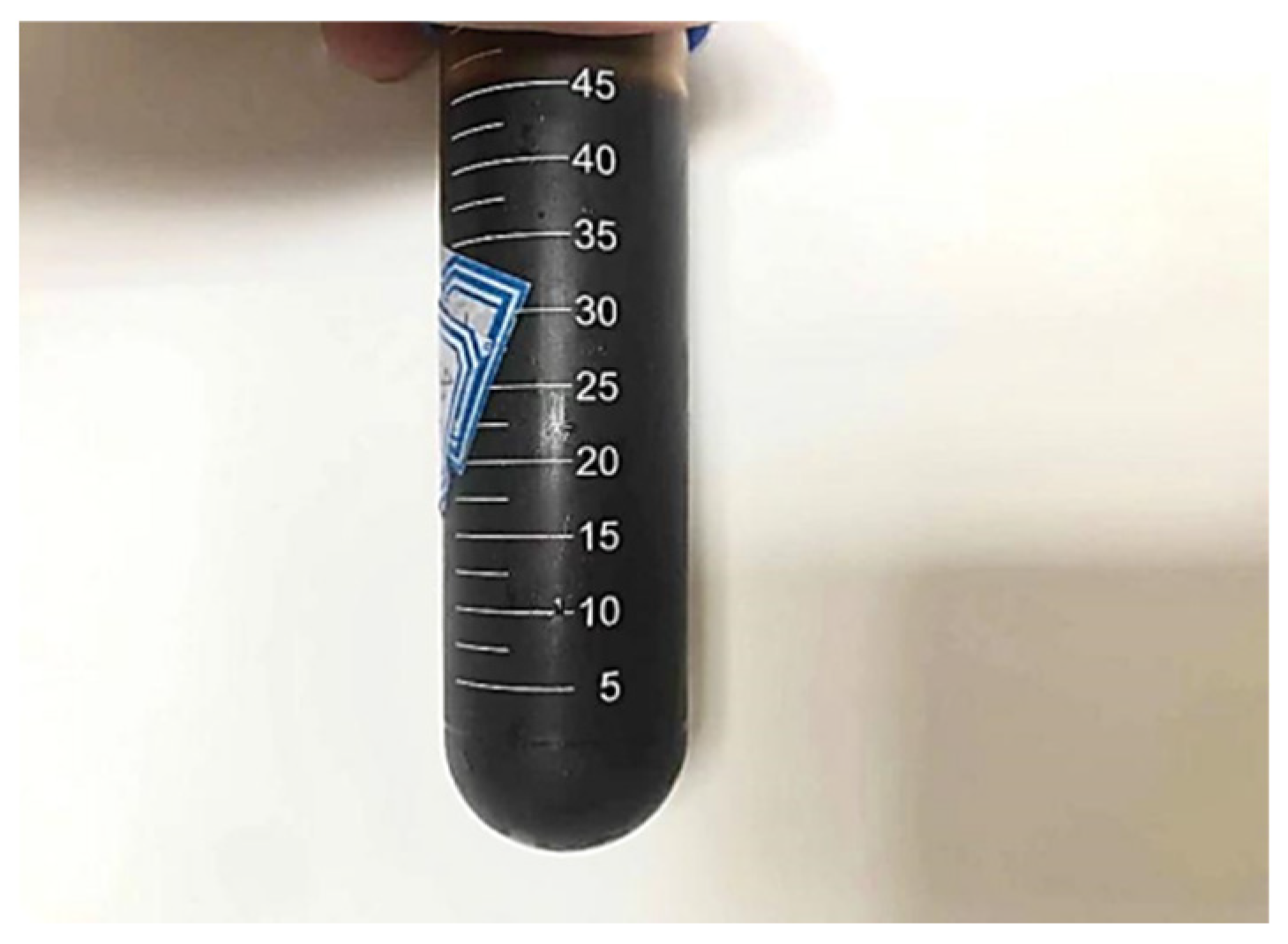

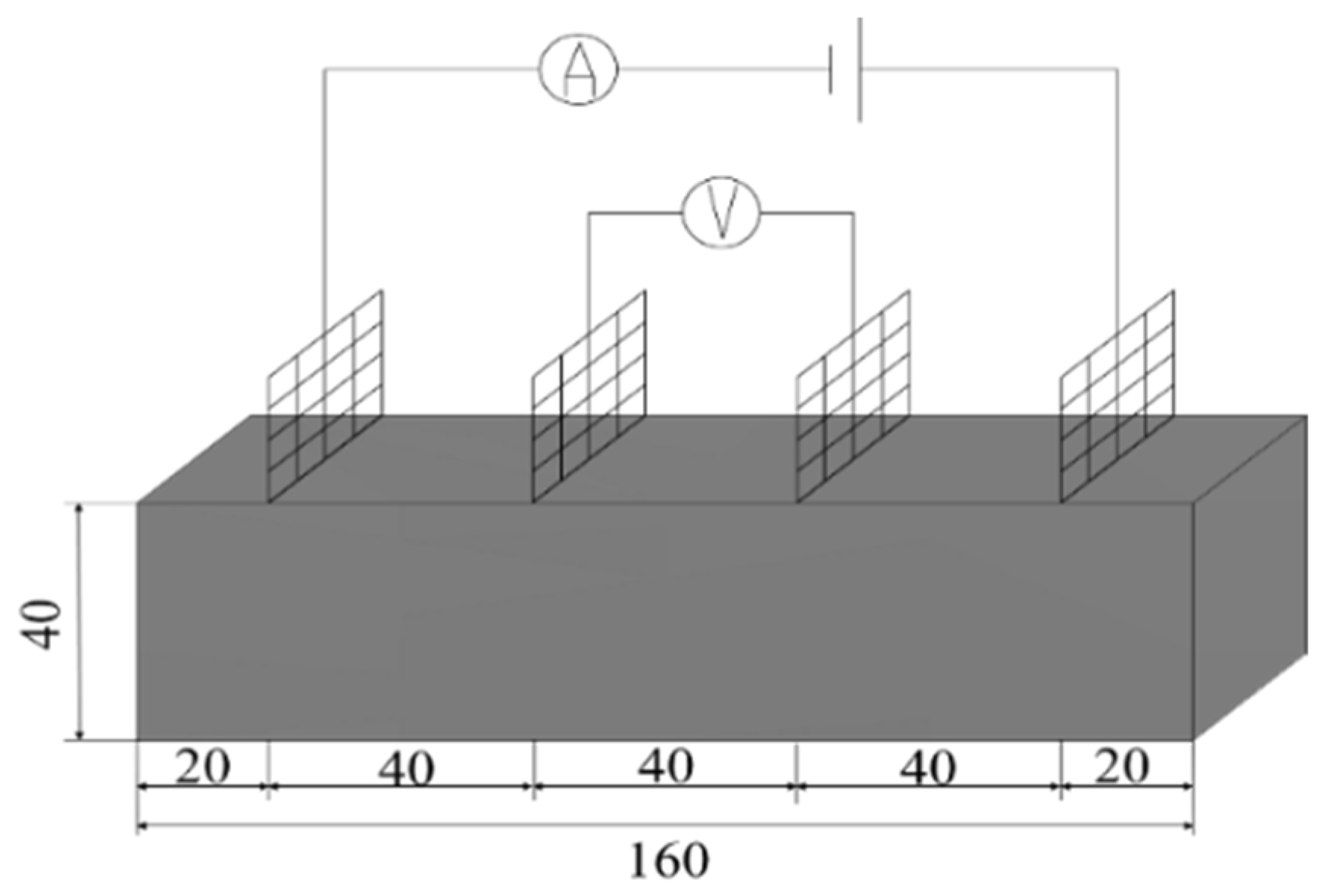
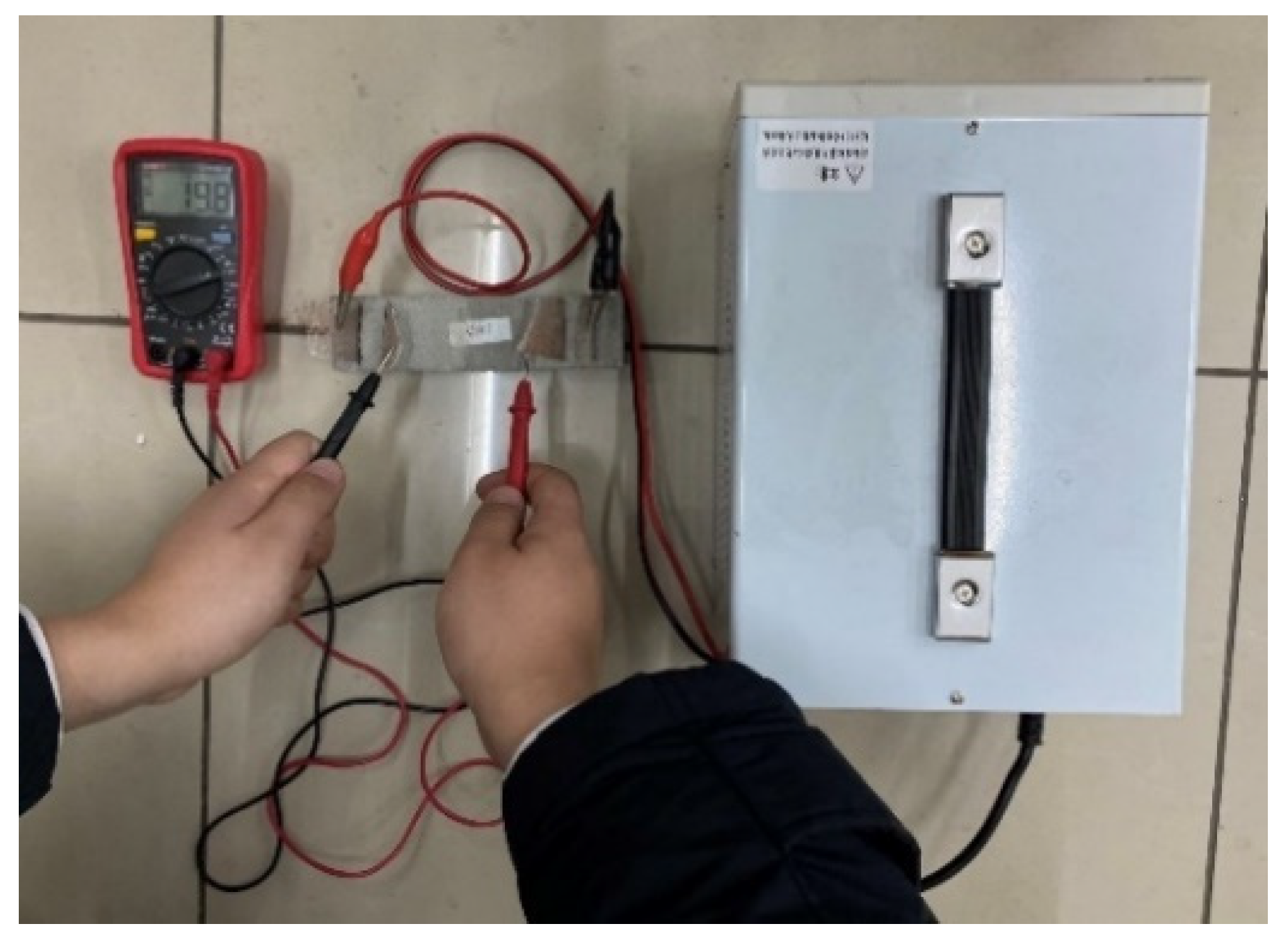
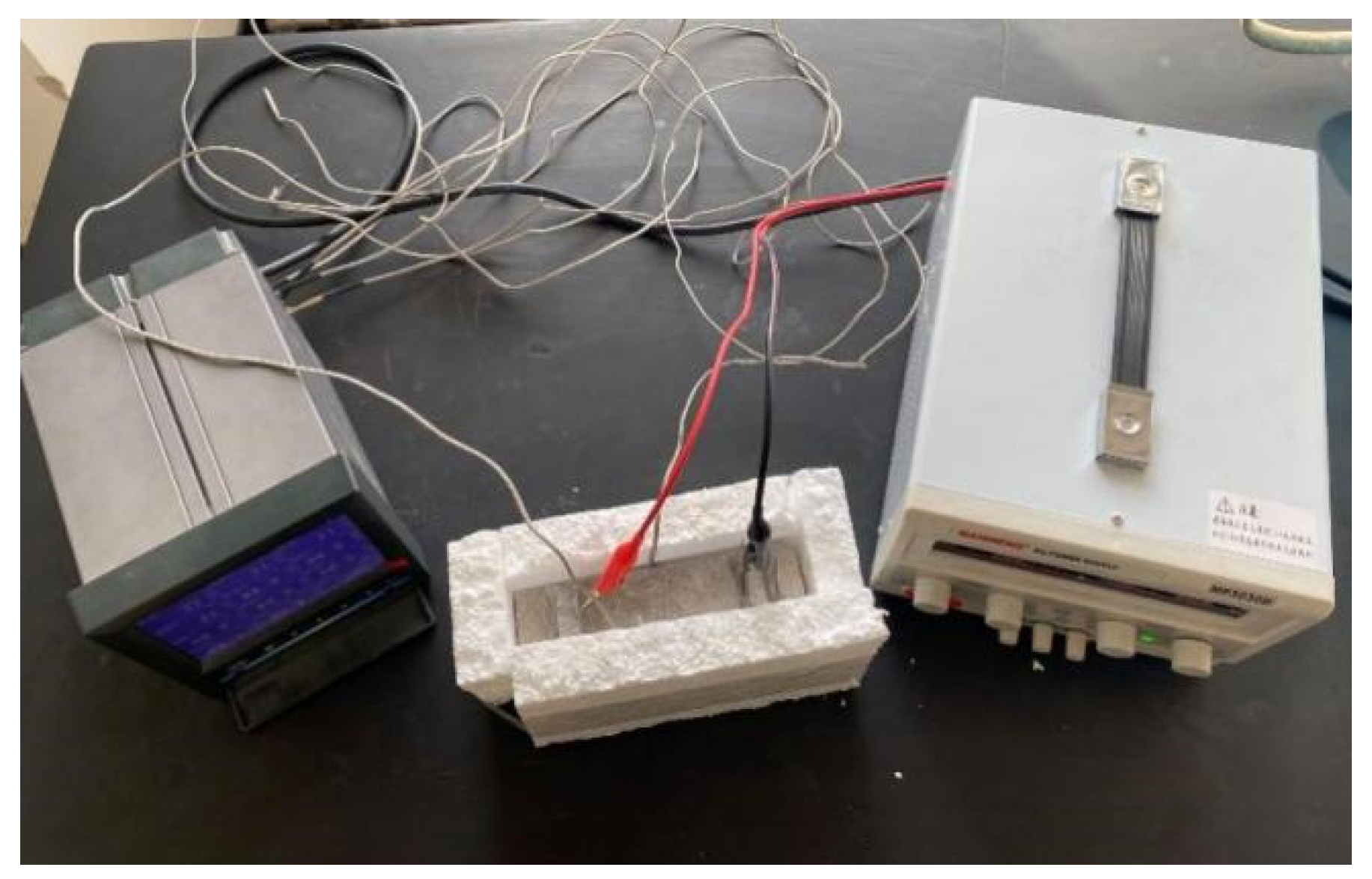

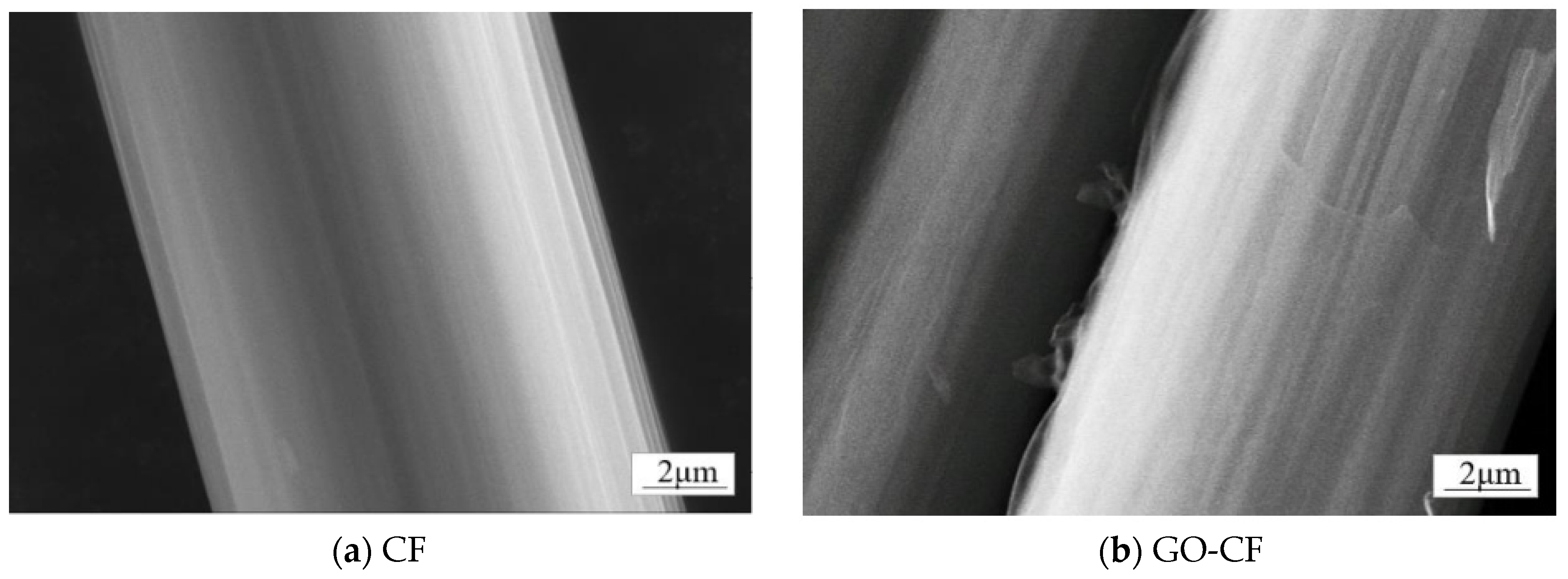

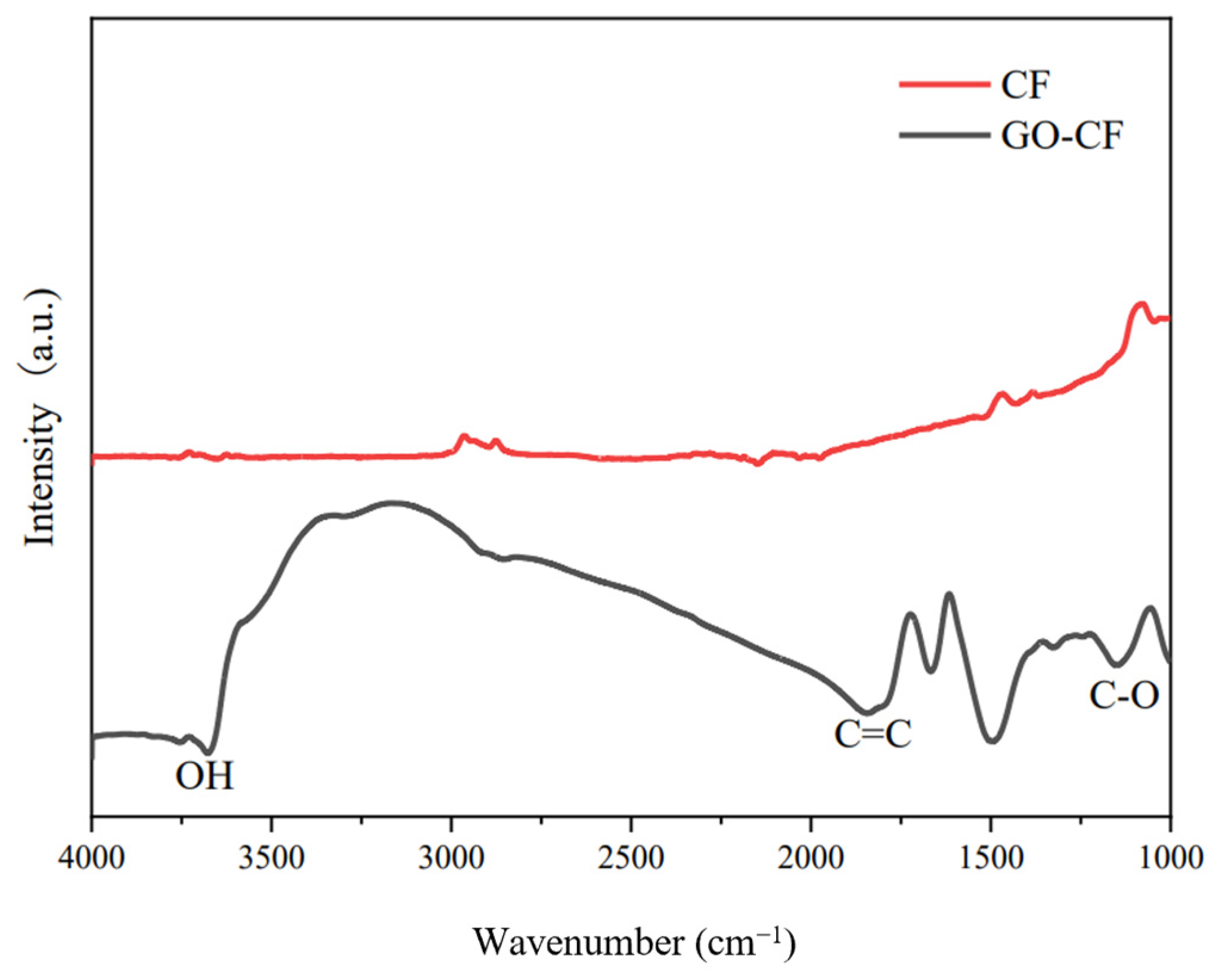
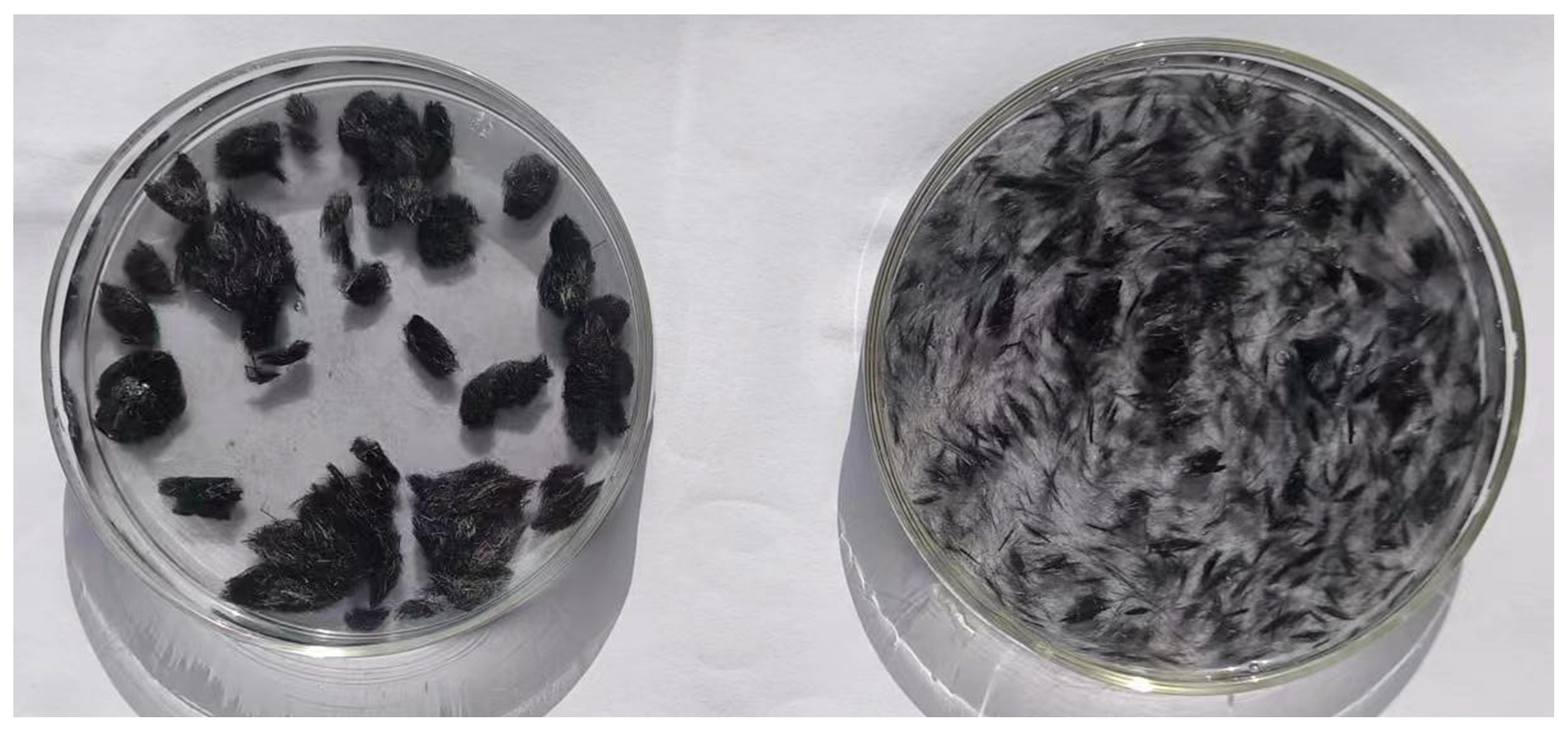

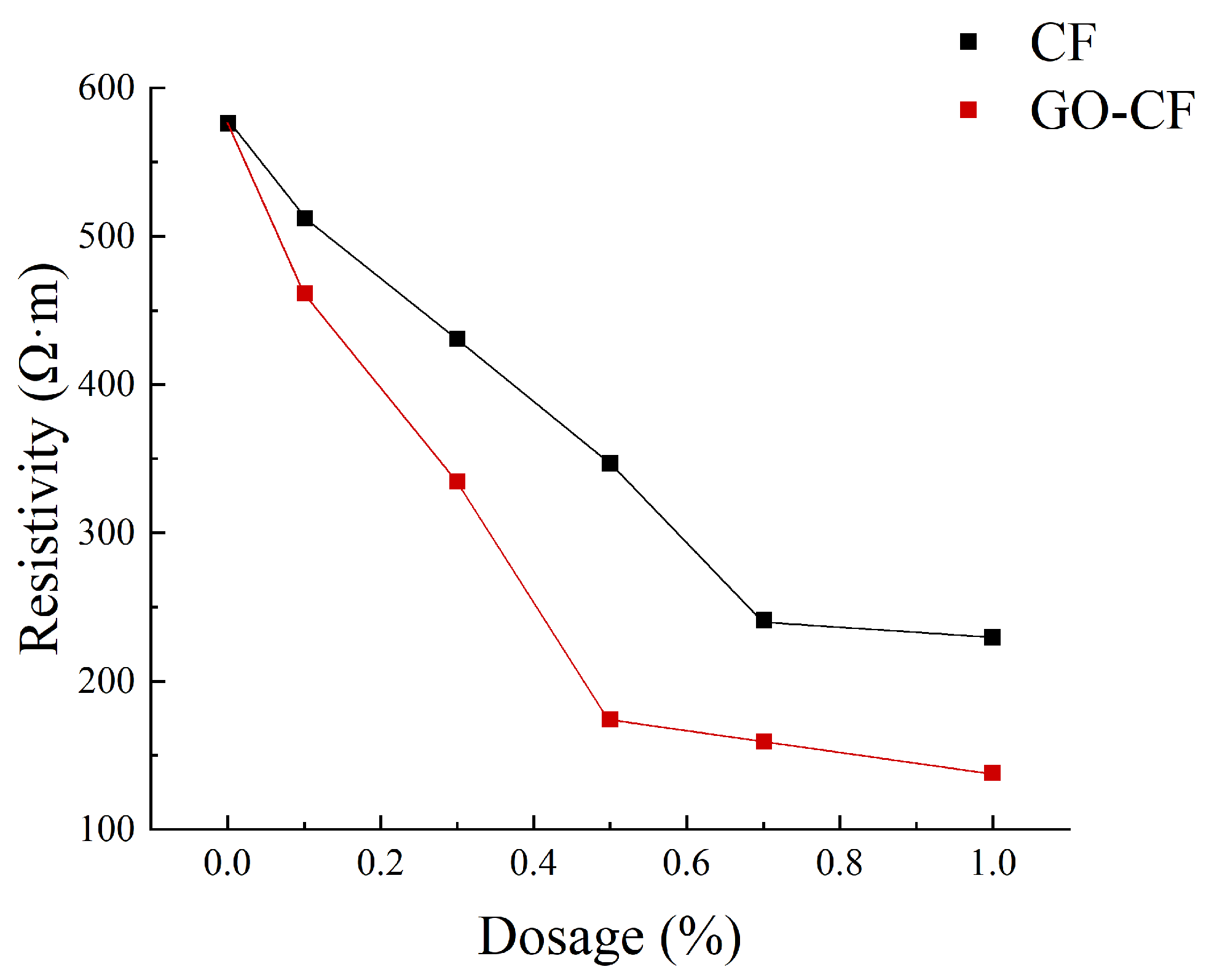
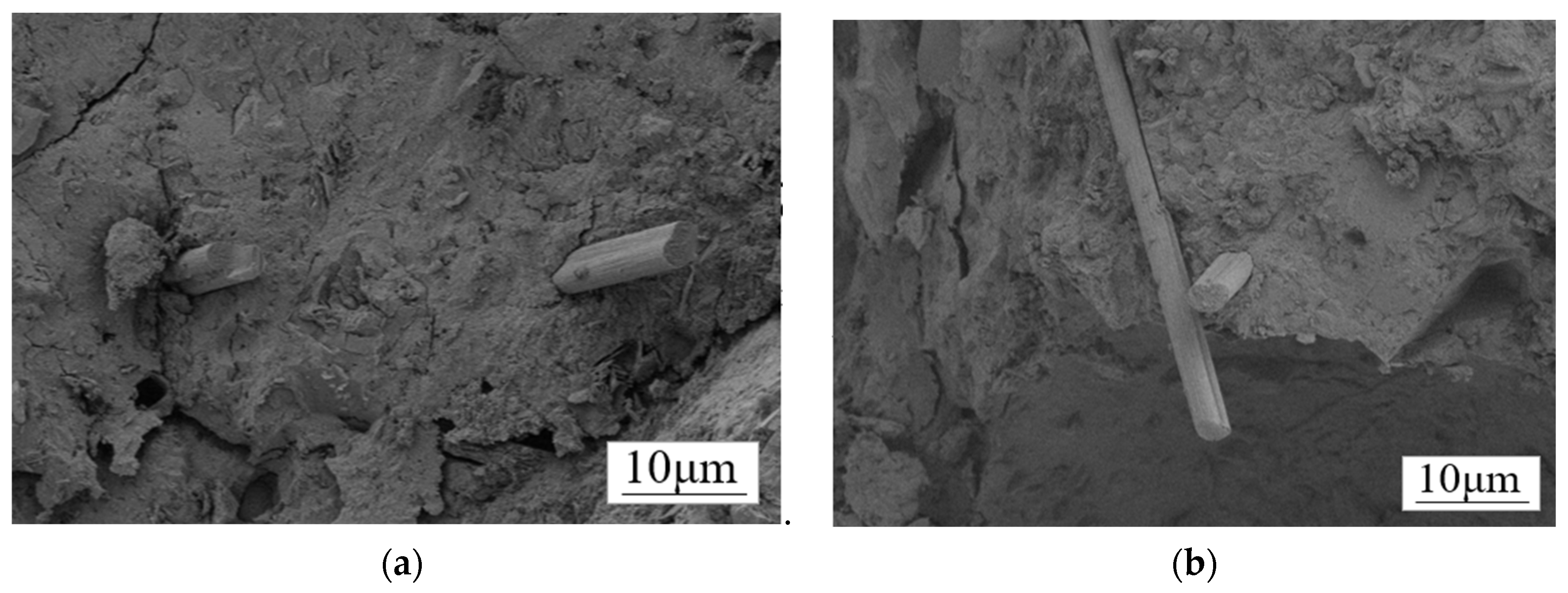

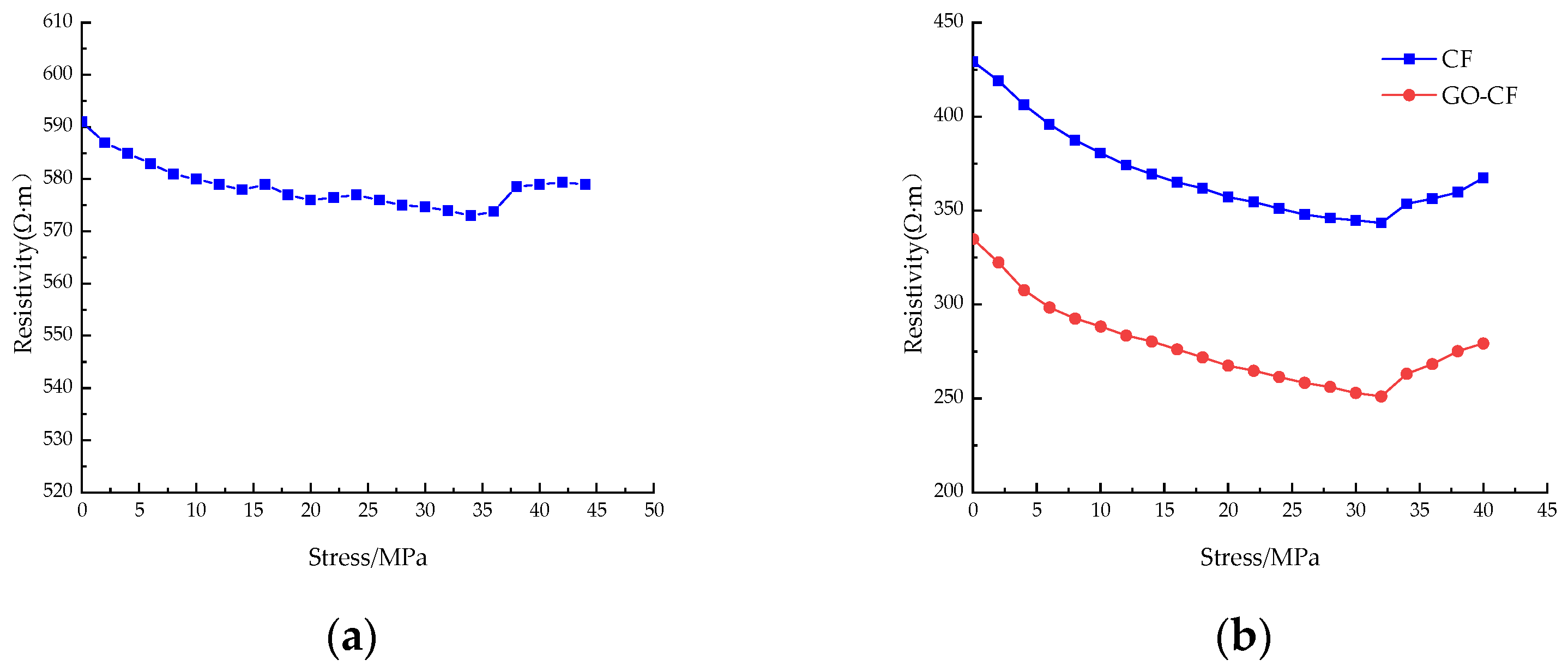
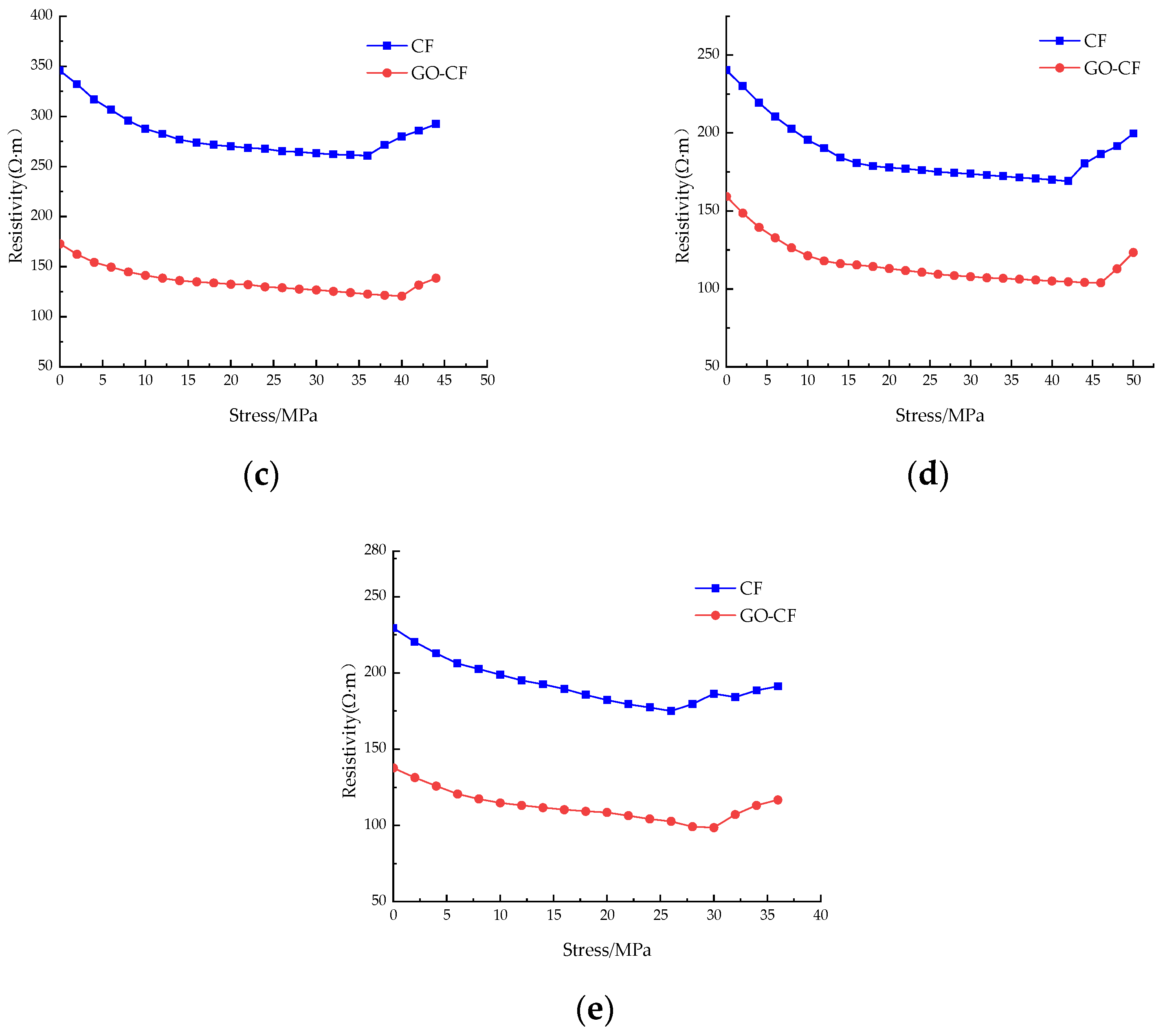
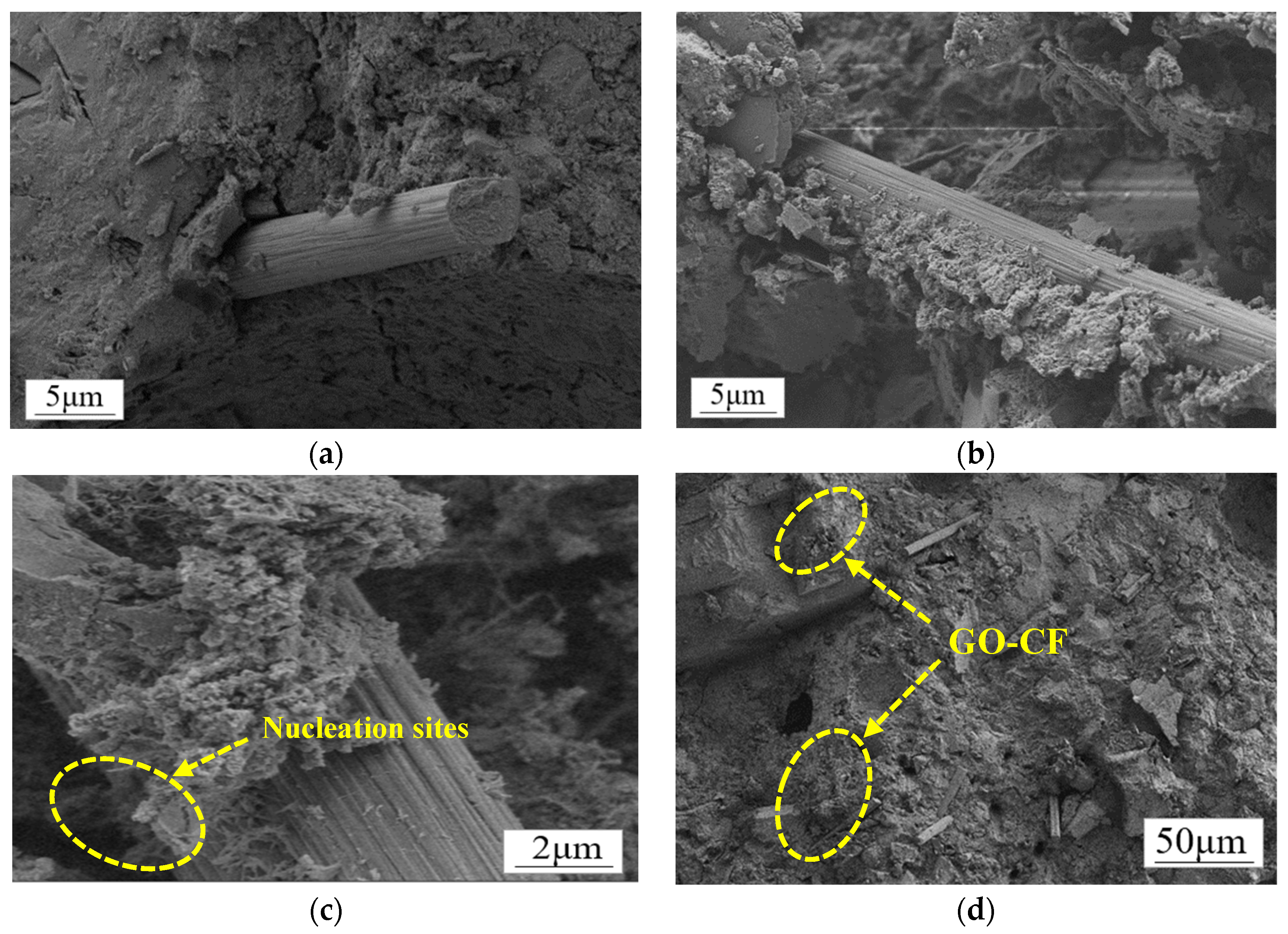
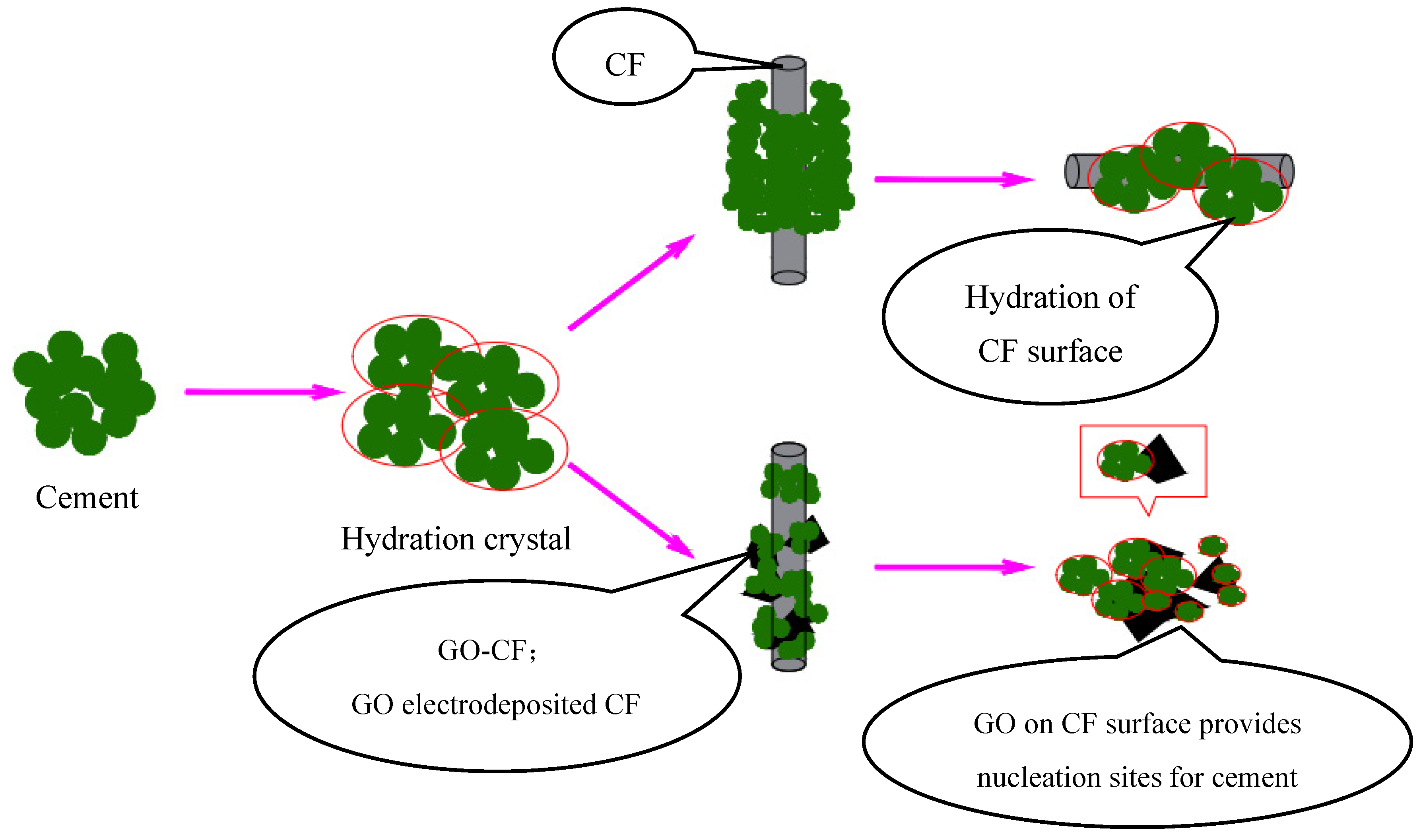
| Main Content | CaO | SiO2 | Al2O3 | Fe2O3 | SO3 | MgO |
|---|---|---|---|---|---|---|
| Ratio (wt%) | 66.30 | 19.60 | 6.50 | 3.50 | 2.50 | 0.70 |
| Ignition Loss (%) | Initial Setting/Time (min) | Final Setting/Time (h) | Specific Surface Area/(m2⋅kg−1) | Flexural Strength/MPa | Compressive Strength/MPa | ||
|---|---|---|---|---|---|---|---|
| 3 d | 28 d | 3 d | 28 d | ||||
| ≤5 | 180 | 6 | 351 | 6.0 | 8.4 | 30.4 | 53.6 |
| Cement/kg | Water/kg | Sand/kg | PC/kg |
|---|---|---|---|
| 560 | 210 | 1120 | 2.8 |
Disclaimer/Publisher’s Note: The statements, opinions and data contained in all publications are solely those of the individual author(s) and contributor(s) and not of MDPI and/or the editor(s). MDPI and/or the editor(s) disclaim responsibility for any injury to people or property resulting from any ideas, methods, instructions or products referred to in the content. |
© 2024 by the authors. Licensee MDPI, Basel, Switzerland. This article is an open access article distributed under the terms and conditions of the Creative Commons Attribution (CC BY) license (https://creativecommons.org/licenses/by/4.0/).
Share and Cite
He, J.; Wang, X.; Han, L.; Wang, S.; Xin, M. Effect of Graphene Oxide on the Electrothermal and Pressure-Sensitive Properties of Carbon Fiber Cementitious Composites. Materials 2024, 17, 3928. https://doi.org/10.3390/ma17163928
He J, Wang X, Han L, Wang S, Xin M. Effect of Graphene Oxide on the Electrothermal and Pressure-Sensitive Properties of Carbon Fiber Cementitious Composites. Materials. 2024; 17(16):3928. https://doi.org/10.3390/ma17163928
Chicago/Turabian StyleHe, Jingjing, Xuezhi Wang, Leiying Han, Siyue Wang, and Ming Xin. 2024. "Effect of Graphene Oxide on the Electrothermal and Pressure-Sensitive Properties of Carbon Fiber Cementitious Composites" Materials 17, no. 16: 3928. https://doi.org/10.3390/ma17163928






